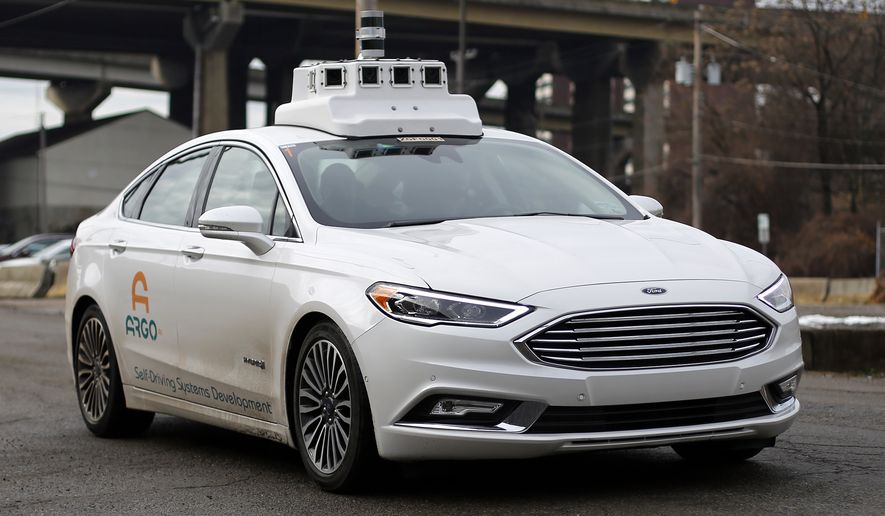The nation’s capital early next year joins a roster of cities across the country where self-driving cars are being tested amid the real-world conditions of everyday commuter traffic.
D.C. Mayor Muriel Bowser announced Monday that Ford Motor Co. will deploy a fleet of up to 10 self-driving, or semiautonomous, vehicles in the city in February as part of the automaker’s nationwide push to test driverless cars. In the city’s pilot program, the high-tech autos will aim to carry passengers and make deliveries across the city by 2021, officials said.
Supporters of self-driving cars say the artificial intelligence that controls them will remove human errors that cause accidents.
However, D.C. officials on Monday did not guarantee that safety information gleaned from the program would be shared with the public, and analysts say the technology is not ready for fully autonomous driving.
“We have been focused on it the last several years — making sure we have the infrastructure, that we had the regulations and the laws to be supportive,” Miss Bowser said to a group of 50 people at a news conference on the Wharf in Southwest. “And most importantly, that we could track the progress and the safety and benefits to the District.”
Sherif Marakby, CEO of Ford Autonomous Vehicles LLC, showed an example during the press conference using a four-door sedan with an array of sensors mounted on the roof in a large beige case. The sensors gather data about the road, other vehicles and traffic signals, among others, and an onboard computer processes the information with regard to updated street maps to direct the driverless vehicle to its destination.
The D.C. vehicles will be housed and serviced in a Ford facility between Costco and Goodwill stores in Ward 5.
When the pilot program begins in February, a human driver will sit behind the wheel to monitor the vehicle as it drives itself across the District and maps city streets. Ford also plans to roll out a delivery van (manually driven by humans, for now) featuring side lockers with a security code that customers can use to grab their goods inside.
The safety of such pilot programs have long been questioned and scrutinized, especially after the March death of a woman who attempted to cross a street in front of a self-driving car being tested by car-sharing firm Uber in Tempe, Arizona. The backup human driver behind the wheel apparently was distracted and didn’t notice the woman until it was too late to stop the car.
Mykel Kochenderfer, an aeronautics professor at Stanford University, says backup drivers will likely remain behind the wheel of semiautonomous vehicles for quite a while because the artificial intelligence system operating the navigation will not be ready to perform complicated tasks such as predicting the intent of people around them.
“It isn’t like Disneyland, where things are running on rails,” said Mr. Kochenderfer, who directs the Stanford Intelligence Systems Laboratory and co-directs the Center for AI Safety.
He told The Washington Times that there are problems with the state of the AI technology on the road:
⦁ Camera sensors can spot turn indicator lights, but that doesn’t help the AI if drivers don’t signal.
⦁ AI struggles in interpreting subtle cues, such as cars slowing and easing over to merge, or a traffic cop’s hand gestures.
⦁ The technology can’t adapt to sudden map changes caused by pop-up construction or road accidents.
Mr. Kochenderfer said computer algorithms that promote cautious driving have led to self-driving cars getting rear-ended in California. He said self-driving systems can be designed to allow remote drivers to take control — like a drone pilot — but the connection lags too much right now to help during emergencies.
Besides Ford and Uber, other companies testing self-driving technology in the U.S. include General Motors, ride-hailing firm Lyft and Waymo, which is owned by Alphabet Inc., the parent company of tech giant Google. Test cities include Miami, Boston, Pittsburgh, Atlanta and Detroit, as well as several cities in Arizona and California, such as San Diego and San Francisco.
The federal government has not implemented any regulations on self-driving cars, allowing the states to develop their own rules of the road for driverless vehicles.
The District’s pilot program is subject to the city’s Autonomous Vehicle Act of 2012, which paved the way for self-driving cars but stipulates that they must have a backup driver on board to take control if necessary.
“At some point after a pilot, we may go forward without [human drivers],” said D.C. Council member Mary M. Cheh, Ward 3 Democrat and chair of the Transportation Committee.
Ms. Cheh told The Times that she is excited about the pilot program and that “it would be a great boon to us” if Ford shares its data.
But Brian T. Kenner, deputy mayor for planning and economic development, said he did not know how safety progress would be tracked or how that information would be shared with the public.
“I think our working group is going through the process now of what kind of information we want to capture and what kind of information we want to provide,” Mr. Kenner told reporters Monday.
“We’re open to discussions,” said Mr. Marakby, who also declined to share specifics about the Ford pilot program or the cost of the cars.
• Julia Airey can be reached at jairey@washingtontimes.com.




Please read our comment policy before commenting.